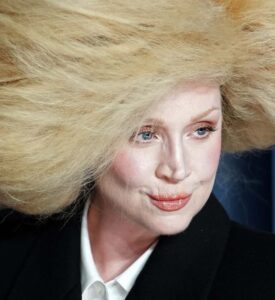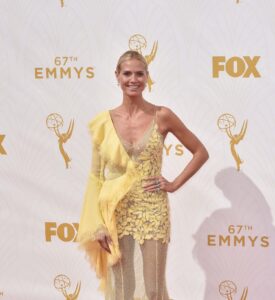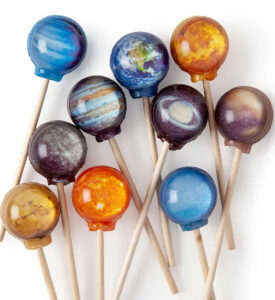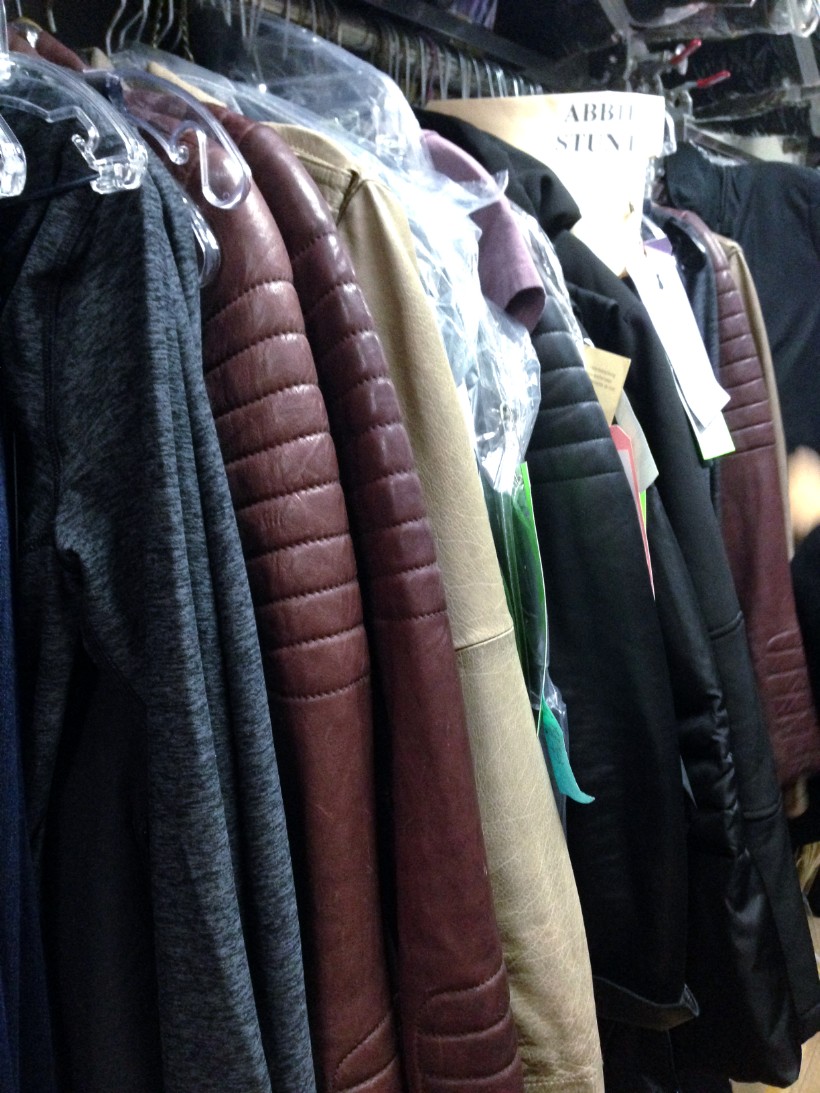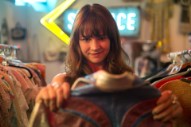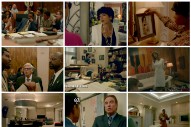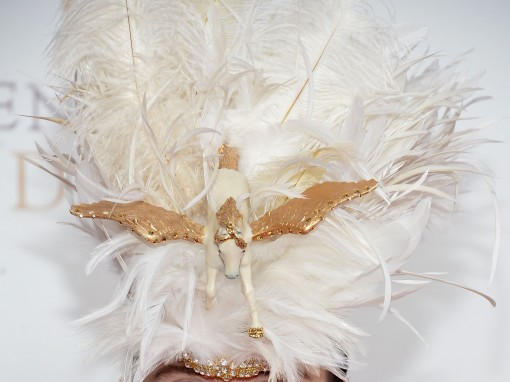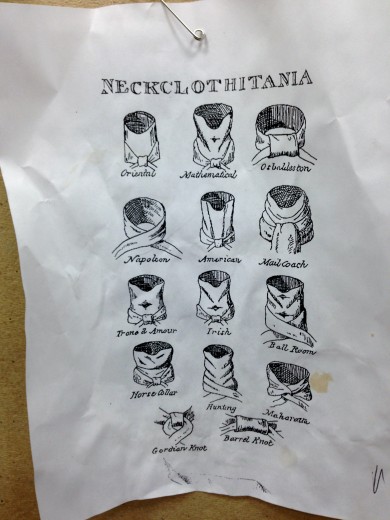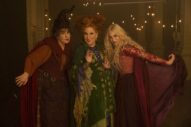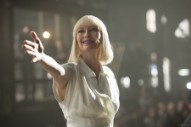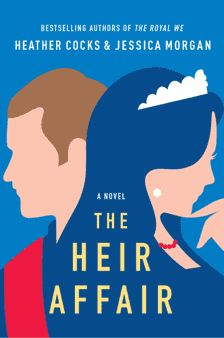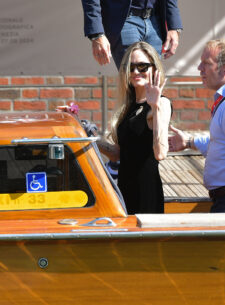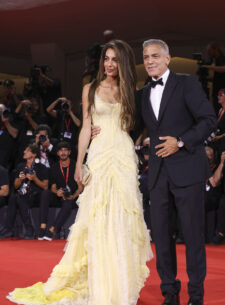If you missed yesterday’s first part about our (unsponsored, unpaid for by anyone but us) visit to Sleepy Hollow, please do check it out, because we saw some nifty stuff. Today’s slideshow involves set photos and a funky close-up look at props for a visual effect involving Victor Garber, among others, and our chat with costume designer Kristin Burke picks up with Abbie’s leather jackets, Oxford robes, the perils of blood, and costuming characters who haven’t been cast yet. If you haven’t seen the finale, you may not have much to worry about — there are a few small visual spoilers in the photographs but overall nothing that spoils the finale’s major moments and CERTAINLY not the ending, because Kristin was careful about that and we didn’t want to know too much. But we put anything pertaining to what we saw into this section.
But first: a chat with Sleepy Hollow’s Julia Rusthoven, who is Tom Mison’s personal set costumer and the founder of Hearts of Hollywood, a non-profit that encourages clothing donations within the costuming industry. We talked to Rusthoven via e-mail after the show wrapped (we didn’t want to pull her off-set during our visit, because what if there is such a thing as The Wrath Of Mison, and we risked it?). Click here if you want to skip to part two of our Q&A with Kristin Burke, but you won’t want to jump ahead yet, because Julia is funny AND she has a story about Intern George. Which he could’ve told us ourselves IF HE REALLY CARED.
GFY: Hi Julia! Fug Nation will kill us if we don’t ask for your favorite Tom Mison story. Is there anything unexpected about him that people would love to know (which he wouldn’t kill you for sharing)? What’s he like, really?
JULIA RUSTHOVEN: He is kind and friendly and selfless. I don’t know if that is unexpected? I hope not. There are lots of stories that demonstrate how fabulous a human being he is, like how he tries to get me to wear his big warming coat when it is freezing out even though he is the one in a lightweight cotton shirt open to his chest. Or how he is always concerned with the comfort of the background players. He also has a great sense of humor and makes an excellent cup of tea.
One of my favorite stories is from the pilot. The first victim of the Headless Horseman was Ogleby, on the farm, and Abbie and Corbin [Clancy Brown] are called to investigate. The body was a life-size headless mannequin that we dressed, and put blood on its neck stump. It was a scene that Tom was not in, so he had not seen the dummy. After we were finished shooting I put the mannequin in Tom’s trailer, on the toilet, with its pants down and reading a newspaper. Not a particularly original prank, but it always gets a good reaction if you close the door to the bathroom — it tends to get a good startled scream out of its victim. My favorite part of the story is that Tom did not realize that I was the one who had put Ogleby there (it was back when he was still under the impression that I was sweet and innocent). He was so tickled by the joke that he tried to continue the gag by calling me into the trailer, to scare me with my own prank. He later swore he would get me back, but has yet to follow through… perhaps he is just waiting until I will least expect it. Some time in Season 4, I will find a bloody horse head in my drawer in the costume truck.
GFY: We joke that your job is Touching Tom Mison, but it’s a lot more involved than that. Can you just give us a rundown of what you do for Sleepy Hollow?
JR: I have two main responsibilities as a costumer. The first is to my designer. I am in charge of maintaining the integrity of her costume design for each of the characters I watch. This includes continuity as well as repairs and maintenance of the costumes (maintenance being a fancy way of saying I wash other people’s dirty socks). The second half of the job is making sure the costume helps instead of hinders the actor’s performance; this means for example keeping the actor as comfortable as possible in bad weather (keeping them cool when they are wearing a wool coat in 90 degree weather, and keeping them warm when they are shirtless in freezing weather) and adjusting the costume for the needs of the scene. Like stunt work, for example. Costumers also get to do fun things like cover actors in dirt or blood. I personally love getting things bloody. (Not sure what that says about me?) Though touching good looking people in the process is not a bad job perk.
GFY: We imagine there’s a lot of pressure in continuity — making sure the clothes fall just-so, etc. What are the organizational aspects of your job?
JR: It requires a lot of pictures and taking very detailed notes, which we keep track of in large, overstuffed binders called Continuity Books. On Sleepy Hollow, however, Ichabod Crane’s continuity is one of the easiest to track since he almost never changes clothes!
GFY: Kristin said Tom personally requested you after the pilot. How good did THAT feel — and what kind of working relationship do you two have? Do you get to know each other pretty well, or do you not spend that much time actually talking because you’re popping in and out?
JR: It is always extremely flattering when an actor requests you personally for a job. In Tom’s case I was particularly excited because I had so enjoyed working with him on the pilot. As I told him after the pilot wrapped, he has become my new favorite actor to watch, replacing Hugo Weaving who had held the top spot for six years (sorry Hugo, [but] there is no shame in second place). I love our working relationship; it developed so effortlessly. Tom really respects the work of all the crew, including costumes, and is very considerate of the costume pieces themselves, never doing anything that might harm them. He is also conscious to make sure the costume always looks its best on camera.
GFY: How do you get comfortable with a celebrity so quickly, in a situation where you DO basically have to get all up in their business all the time? How do you build that relationship? And have you ever encountered an actor who isn’t actually that comfortable with it?
JR: It can be a tricky thing developing a comfort level with an actor. You may have to tape nude coverage patches over their naughty bits the same day you have met them! Luckily actors are just as used to having to make these fast relationships as we are, so most of the time it is not a problem. Working the long hours we work, often six days a week, you do get to know people pretty well. Even on the busiest of days there is always some down time to talk. I find it is helpful to be super open and friendly myself from the get go. After that I just try to be as observant as possible of the actors’ reactions to our interactions and adjust my behavior accordingly. Every personality reacts to the strange requirements of our business differently. There are some that do not like to be touched; they find it distracting. So for those I avoid adjusting their costume as much as possible. Other like the reassurance of being “checked” after each take. A lot of being a good costumer is being good at reading people.
GFY: How do you handle it if either of you is just SUPER crabby that day, or haven’t had your coffee, or whatever?
JR: Crabby days certainly do happen with our long hours! Usually when I am having a grumpy day I spend most of my energy trying to hide it so doesn’t become a distraction to my actors, or other costumers. If I notice an actor is having a difficult day I just try to give them space so as to not make it harder for them. I am very blessed with Tom — we know and like each other well enough that I don’t have pretend to be in a better mood than I actually am on those days, and I don’t think he feels any pressure to put on a false happy face around me either. Fortunately the show is so much fun to work on that those days are pretty rare.
GFY: How long is a standard day on the set, for you? Do you have anyone who spells you so that you can sleep in or something, or are you there every day for as long as Tom is? He’s in so much of every episode that you probably don’t get many breaks.
JR: We work on average a fourteen-hour shooting day, which means I work between fifteen and sixteen hours (coming in about half an hour before call and staying half an hour or more after wrap). Except in very rare circumstances, like when I took the day off to attend a Christening, I am on set with Tom full-time. We have a fantastic costume team though, and all of us are ready to step in to relieve each other should it be necessary. Pauline White-Kassulke, our key-costumer who runs the truck, often has the earliest in-time, so I get to sleep in a little bit, and Janet Marie Ross, my set partner, will cover me on set when I just can’t wait any longer to go to the restroom.
GFY: What was the toughest day on set for you, or for you and Tom as a team?
JR: One of the hardest days on set was probably filming the Roanoke well scene [“John Doe“]. Anytime you have a wet actor it is a challenge, and it was a particularly chilly day even for those who were dry. Being wet is difficult for the actor because they are uncomfortable and cold and have to add “Concentrate On Not Shivering” to their performance. It is difficult for costumers because we are running in after every take with towels, robes, comfort shoes, and sometimes hot beverages. In addition to Tom, two other actors had to get into the well that day; two of them got completely submerged, one of whom was a minor. We also had an entire colony of day players and background [extras] in period costume, and one of the horseman of the apocalypse; it was a lot to juggle.
GFY: What’s the toughest aspect of his costume to wrangle?
JR: The biggest challenge of Crane’s costume would have to be his gravity-defying shirt collar. On the pilot I quickly discovered that starching the collar was not enough to maintain its beautiful Dracula-like, face-framing form. After a lot of experimentation I eventually found that a combination of lightweight interfacing, a center back stay, and wiring the collar was the best way to keep it upright and also gave me control over the shape.
GFY: When you work in this kind of capacity, do you find yourself getting really protective of the actors — we feel like we’d be all, “Tom is TIRED, CAN’T WE ALL JUST LET HIM REST?!?” — or developing friendships with them that go beyond the shoot itself?
JR: I do have the tendency to become very protective of my actors. Some of this is built into the nature of the job and some of it comes from the fact that I am the oldest of six, so my “big sister” habits kick in. These natural bents are only increased by the fact that Tom is so kind and polite that you not only want to protect him, but you worry that if you don’t, he won’t stand up for himself and will just stay quietly uncomfortable. It is pretty safe to say that the Sleepy Hollow [assistant directors] have gotten more of an earful from me about Tom’s comfort than they have ever gotten from him. Luckily they are patient with me, and they also want him to be comfortable, so they are willing to oblige.
GFY: You worked on The Hunger Games, which is a costume-fest, obviously. Any fun stories from the set of that film?
JR: Hunger Games was a really fun job. Like Sleepy, there was a huge variety of costuming styles to work with: District 12 was based on ’40s fashion, and then the Capitol was all futuristic high fashion. I was lucky enough to have watched Elizabeth Banks [Effie], who I thought had the most fun costumes of the whole show. And also some of the most difficult for the actress — those shoes were insanely uncomfortable.
GFY: And, you did Leatherheads. George Clooney has been a longtime intern at GFY (although he has never shown up to work, not even once) and so Fug Nation will ALSO kill us if we don’t ask for any good Intern George stories from that set.
JR: How nice of you to keep him on staff despite his poor attendance! I didn’t work directly with George but was very impressed with everything I observed of him juggling writing, directing, and starring in it. He must have been getting practically no sleep with so much to do and yet he was always full of life on set. I do remember that he loved pranks. He was a real boys’ boy and particularly liked working with the football players. On the last day of shooting we were working on the game scenes and the field was very muddy. He told the teams that their uniforms were too clean and kept having us add mud to the costumes, and then eventually, he said, “No, still too clean,” and made the players lay down and roll around on the wet ground until they were completely covered head to toe — I mean no visible skin, in cold, wet mud. He then said, no, that was too much mud, and personally “cleaned them off” by spraying them down with an industrial hose. When they were clean but shivering and soaking wet, he announced that there was actually nothing else to shoot, they were wrapped, and he had just been messing with them the whole time. They mostly groaned but he was giggling like mad.
GFY: We hear you guys have all the hot set gossip. What’s the most gossip-heavy set — either in terms of the AMOUNT of juice, or quality of juice — you’ve ever been on?
JR: I have been fortunate not to have worked on too many gossip-heavy sets. Gossip is just not healthy for any work enviroment. It is especially dangerous in our business where there is so much outside interest in the players. Our costume designer, Kristin Burke, compares it to bursting open a feather pillow — once something is said, and the pillow breaks open, the feathers fly everywhere and there is just no containing them. We do get to know a great deal of personal information about actors because of the nature of the job. I try to think of it in terms of doctor/patient confidentiality. I wouldn’t want my doctor telling their friends about how funny I look naked, or that I cried when I had to have a shot… and it is so much worse when the story could be printed in a tabloid. It is even more serious when you consider that actors in part make their living based on their reputation. I am always happy to share stories about how kind or funny an actor is but I try not to say anything that could damage their reputation, even if the bad behavior is directed at me. We work hard, long days; nobody can be expected to behave perfectly at all times. I try to cut people slack on their bad days just as I hope people will be patient with me when I am short with them.
A classy response from a classy lady. Thanks, Julia! And now, part 2 of our chat with costume designer Kristin Burke.
HEATHER: Let’s start here with Abbie [Nicole Beharie]. What’s the approach you take with her costumes? She seems deceptively hard – Ichabod has all the showy stuff, but you probably have to be more careful how you dress her than people realize, so she doesn’t get lost.
KRISTIN BURKE: Abbie is a cop that starts the show in the uniform. After episode one, she’s not wearing the uniform anymore. Everybody wanted her out of the uniform and I get that. Abbie in her uniform, visually, didn’t go anywhere, didn’t grow, was too static. Abbie as a plainclothes detective could shift her look, pick up visual cues from her environment, and we could make it grow as she grows. Does that make sense? We just had a lot more freedom with her in plainclothes — freedom to tell her story through costumes. She’s no-bullshit, straightforward, you know, so we can’t put her in girly things and we can’t put her in anything impractical. Everything is very functional, but at the same time, there’s a cuteness about Nicole that we wanted to play. We’re not going to put her in clothes that make her look bad or that make her look unfeminine. We need to use that, with her.
H: People love her leather jackets, and her shirts.
KB: The shirts were James Perse, and now they’re Bella. But we’re moving into things that are a bit more like athletic wear, so we’re using stuff from Under Armour and Nike and that kind of thing.
JESSICA: People will want to know where some of the jackets came from. Abbie’s coats are GREAT.
KB: We get everything of Abbie’s online. EVERYTHING. Usually Barneys.com, Bergdorf Goodman, and Neiman Marcus.
J: So they’re high-end leather coats.
KB: We do not fuck around. For a few reasons. I know they’re going to be constructed well, and if I see them… like, if you go to Neiman Marcus’s web site, you can see the stuff in action. You can see it on a runway model. So between my experience with clothing and the videos, I can tell exactly how it’s going to fit the body. It’s a tremendous marketing tool.
H: Does Abbie rotate the same few coats, or abandon some of them and replenish?
KB: There are some that we have abandoned. She’s had enough of the beige Superdry jacket. But we have an Allsaints jacket and a Vince jacket… we have a LOT of leather jackets.
J: I like the idea that this woman has a secret leather jacket shopping obsession. And she’s at home at night in her pajamas ordering leather jackets.
H: I feel like Abbie doesn’t spend a lot of time at the Sleepy Hollow mall.
KB: No, and you know, her Sleepy Hollow is so close to New York City, there’s every reason to believe that she has that level of sophistication. I don’t have a problem with it.
J: No, I fully believe that girl is at home buying leather.
H: Googling demons, and shopping her demons.
KB: She also does have an Akris leather jacket. It’s an investment piece. But Nicole wears that leather really well. What are you going to do? Our work is a collaboration, so we have to work with whatever tools we have, and those tools are the actors. And I don’t mean that in the mean sense of the word “tool.” [Laughs] I work with what’s in front of me, and she looks good in leather jackets, so she is going to wear leather jackets.
H: And with her, you can collaborate like that. It’s not like Tom can come in and be like, “Well, I look good in tube tops, I think Ichabod should wear tube tops.”
KB: Well, he could come say that.
H: It would be awesome if he did.
KB: Maybe we can have an alt-reality episode.
H: But since he took the part of Ichabod, what comes with that is wearing what Ichabod wears, and that’s kind of that. But she theoretically could be more demanding about what Abbie should wear.
KB: Nicole is very, very character-first. And she gets it. She knows this woman inside and out, and I know her through Nicole, you know? So we don’t even really have to have a conversation. She’ll call me sometimes or send me an e-mail and say, “Did you see this top?” And then we’ll order some tops, and sure enough, it looks great on her. So that’s a very easy relationship, because we both understand what we’re doing there. A good relationship with actor means that there is trust. They trust us to make them look appropriate for the character, to bring that character to life. We trust them to make it all work. When trust breaks down, it is hell on earth. Trust is crucial to our job. I cannot over-emphasize that. Nicole and I have a good relationship and it’s such a pleasure.
H: You talked to us a little today about a coat you had to make for John Cho.
KB: Oh, yes, the wax denim coat. That was an “Oh Shit” moment, where I was like, “It doesn’t exist.” So, John Cho’s character is in love with Abbie. And he becomes weak when she rejects him. He goes to Moloch [the demon who wants to bring forth the apocalypse] and says, “I don’t want to be weak anymore, I’m at the beck and call of this woman and I don’t like that.” Moloch makes him a deal, and he gets put in this cocoon and emerges with superhuman strength, naked, covered in goo. And there was a scene, I’m not sure if they’ll use it or not, but it’s like the Terminator moment where he walks out and he’s like, “That’s a nice coat,” cut to, the guy dead on the ground and John Cho wearing the coat. You know? That kind of thing. The director was very keen on was having him in a long trench coat that had a lot of, like, gravitas.
H: That sounds very Underworld.
KB: Yes, and in looking for a long trench, I wasn’t finding anything appropriate. But in the time of me looking, because I really thought I’d find it, we lost valuable days we could’ve used to make it. Our team in LA is a workroom that’s run by a guy named Serj, and he’s pretty well known in the industry. He is five tons of get-‘er-done. He’s awesome. We really have relied on him. And I owe him a personal debt of gratitude for everything he’s done for us. He really went there. It was nice. And he made that wax coat in LA and sent it to us and it looks fantastic. But we haven’t had a fitting with John Cho yet [ed. note: They had quite a few shooting days left at the time of this interview] have to watch the finale to see how it worked out] so we’re waiting to put on the belt loops.
H: That coat was great. It’s very cool. [Ed note: See slideshow for our mediocre pic]
KB: Glad you like it. You’ll see it on the runways next Fashion Week. [Laughs]
J: How many things would you say you’ve had to make from scratch?
KB: On every episode, we’ve had to make at least two or three things. On average.
H: How many did you have to make in duplicate?
KB: All of them. All of them. We don’t make just one. Never.
H: If you had all the budget in the world would you just want to make everything yourself? If you could? Or is it nice to pick and choose?
KB: There are some pieces that we get from different rental houses and stuff that are really inspirational pieces, so I look at some things and I go, “Wow, that makes me think of all of this other stuff,” so it becomes a jumping-off point to make something. But obviously if I had all the money in the world…
H: So when you see Katrina is supposed to be in a ball gown, your mind goes, “Oh the ball gown I could make, except, oh, the ballgown I can’t make.”
KB: Absolutely. The ballgown we can’t make, because budget restrictions say we can’t make it. But Katrina the Quaker gown? That was nowhere to be found. Something THAT plain. Nowhere. Like, all of the eighteenth-century stuff is beautiful prints or, you know, each one has a little something to it. There was very little that was that simple in her size. And so for us, on a practical level, it was like, you know what, let’s cut bait, let’s just do it. We’re getting to two weeks, once that two weeks point has been hit, we’re screwed and we have to invent something. Making a ladies ensemble for this period takes at minimum two weeks. So, once we get within that two week period, we can’t solve the problem by making something. And so there, we were coming up on that two weeks where we couldn’t find anything and I thought, “Okay, well, let’s make something.”
H: And then sometimes you’re making stuff for actors who haven’t been cast yet. Can you describe a little bit about that process?
KB: So, for example, two [characters] that we had to do a lot of stuff for are Abraham Van Brunt [in “Necromancer“] and Lachlan Fredericks, who was in the episode with the Haunted House and the scarecrow guy [“Sanctuary“]. Both these guys, Abraham and Lachlan, meet their demise in these episodes. And in a bloody way. So there’s nothing we could do. We HAVE to make those costumes. We had to have multiples of Abraham for many reasons — he has a sword-fighting stunt double, he gets stabbed and there will be a big hole in his costume covered with blood, and we shot this totally out of order, so we need to see him pristine later in the schedule. We had to have a minimum of 3 complete sets, for each character really, just to make it work. And there is no such thing as multiples in this period in a rental house. It doesn’t exist. So we make them.
But, with the two week window, those guys have not been cast. The studio has enough to deal with, they have 15 people trying to decide on one guy… And I know that if I don’t get those costumes into production two weeks out, we’re not going to have them to shoot with. So I have to wager a guess. And in the case of Abraham Van Brunt, I’m like, sigh, this is television. In my world, if I was to cast Abraham Van Brunt, I would cast the equivalent of Chris Penn. Paunchy, debaucherous, like, kind of not a good option for Katrina. Where she’s like, “I don’t want to marry this guy but I have to because I’m socially bound.” That would’ve been my casting choice. A Chris Penn. RIP. But they cast Neil Jackson, and I mean, you could see it coming all the way down Wilshire Boulevard, because it’s a television show, so they’re going to cast a beautiful guy.
H: And they did.
KB: And they did. Knowing that, knowing it’s the proclivity, it’s like, “All right, let’s get this jacket made in a size 42, let’s put two inches worth of space in the selvedge so that if he turns out to be super buff we can make it bigger, let’s aim for this and give ourselves a little bit of wiggle room.” Because if there’s a stunt, we need to adjust it to accommodate a harness, too.
H: And of course when having this made, you’re having two, three, four made.
KB: Four usually. And Lachlan was a dandy, the Bill Clinton of that era, so all that stuff is 100 percent silk faille, and fabulous cashmere coats. I mean, we went for it, because that reads. People watch the show in HD. And HD is not forgiving. If we put somebody in a polyester garment, it reads polyester, and then our job is lost. So you have to commit to the quality that is indicated by the character and the writing. To be able to tell that story.
J: Where would you be getting this stuff made, usually?
KB: We get it made in LA, and oftentimes don’t have the actor even by the time this stuff is done. So they ship the stuff here, and then on the day that the stuff arrives we get the actor’s information. And then we schedule a fitting with the actor and they come in, and we’re like, crossing our fingers, okay, how did we do? For example, in episode 110 [ed: for viewers, that’s 11, which aired last week] we had Ben Franklin. An iconic American figure. Ben Franklin is known for wearing a couple of different outfits. One of them is a brown suit, brown vest, brown jacket, brown pants. That’s what everybody knows Ben Franklin for. And this is supposed to be a youngish Ben Franklin, so I’m like, let’s do Brown Suit Ben Franklin. And then we get the actor’s measurements, and this was actually well in advance of his work which is a miracle. And he had a 50 waist.
J: Well, you could imagine Ben Franklin being jolly.
KB: But maybe not that jolly. So we don’t have anything in our office that would fit him, and definitely not in so much brown. We don’t have it. And he’s in a scene that plays like this [snaps fingers]. It’s a recollection, it’s a memory, we’ll see it for two seconds. But we don’t have the clothes. So we gotta get swatches, we gotta make this thing. We HAVE to make it. So we spend a lot of money making a suit for a guy that you’ll see for two seconds. He doesn’t even have any lines.
H: They’ll spend that much on a suit for a guy with no lines? Can’t they just cast a different non-speaking extra?
KB: This guy didn’t really resemble Ben Franklin. Our transportation coordinator looked more like him. We were like, “Can’t we just use him? We have stuff for that.” But no. So we definitely have the “Oh Shit” moments. But beyond all that stuff, then we get to something like the Oxford professors from today’s shoot [for part of the finale]. I couldn’t find anything anywhere that even told me what to look for that would be authentic, so I called Oxford, like, “I need help, we need to know what these guys looked like, do you have anything?” And two days later they came back with engravings from the 1770s. I mean, are you shitting me? I couldn’t find that at a library. Unbelievable.
H: Then what did you do?
KB: Once I had the discussion with Oxford about what they wore, I contacted Angels costumers in London, and I said, “Here is the research that they gave me, what do you guys have?” And God bless those people at Angels – they have been so patient with us, because we’ve been like, “Okay, we need it in like two days, and we don’t know who the actor is yet.” They’ve been so nice to us. Really saved our butts. Anyway, I sent them the research and they’re like, “We have something similar, it’s not exactly period, but I think it’s timeless enough that you can get away with it.” So they suggested the robes and the collars and the hats. Because that’s the place where you get them. You don’t get them from LA, you get them from the place where they are used. And the suits that went under that, all that stuff came from Italy from another pull that we had done a long time ago for some other stuff. And we just kept that stock. And it smells really bad. The STANK. But that’s what Dryel is for.
J: So Dryel works?
KB: Dryel works. I was going to rip the lining open and put a dryer sheet in there and just stitch it up, under the arm. It’d totally work. But we were like, “Let’s try Dryel first and see if it works,” and Dryel was like, [snaps fingers], smell is gone.
H: We heard they added a ninth extra to that scene at the last minute. A ninth professor. Did it throw you off?
KB: We had pulled eighteen of those robes just to be safe. Whenever they give us a number, we pull 150-200% of that number, because we know that numbers change and expand rapidly in television. Since those robes came from London, it’s not like we can go, “Whoopsie,” and trot over to the costume house to get more. We have to think big picture, always, and all of the possible chaos attached to that schedule.
J: We should talk about the Hessian masks that you had to acquire [for reference, here is Heather in one].
KB: Make! We made all those masks. Jules [Julia Gombert, ager/dyer] made all of the masks.
J: How many?
KB: Ten.
H: She has her leatherworking merit badge.
KB: Her scouting vest thing is full of badges at this point.
H: She talked about hardware for the back, which frames the head tattoo, and how nobody had it.
KB: Nobody had it in the quantity that we needed, which is not an unusual story for being in Wilmington. We called a store in Raleigh and they said they had it, but they didn’t send it all, and so it’s just… it’s small market, and it’s frustrating.
H: Does it ever happen that they say, “We need twelve,” and you say, “I cannot get more than six, period”?
KB: No. We have to figure it out. We have to. We have to call LA, we have to call New York, we have to call wherever. We have to make it happen. Whether it’s somebody foraging, turning to blacksmithing [laughs], or going to Staples and getting a binder ring that we can repurpose… you just have to get creative.
H: And Darek is the tailor who’s your immediate fix-it guy, right? How quickly has he ever had to turn around something?
KB: We try to keep him on a ten-hour day, so that he has a life. But [in the finale] John Noble has to wear the same shirt as [another actor in another episode]. And the previous shirts were made with Serj in LA, and we didn’t know they were going to need that again later on. Fortunately we just happened to have some yardage of that shirt, but when I got the script, I was like, “Oh, no, he’s got to wear the same stuff.” I went to Darek and I was like, “Here’s three yards of this fabric, can you do it?” And he did it, and it was torn apart [for the scene]. And then he had to make a stunt double. But we didn’t have any more of that fabric, so it’s like, “Okay, do we have anything that LOOKS like it?” I mean, it’s just like one thing after another.
H: I can’t imagine being Darek, working all night on a shirt, and then they tear it up.
KB: I think there’s a moment of sadness but then it’s like, okay, well, next thing. It’s the job.
H: Do you often get that feeling of possessiveness about costumes when things happen to them?
KB: For me it’s all about telling the story. So I’m kind of stoked when I see Jules [the ager/dyer] go to town on something and fucking killing it. It’s like, okay, awesome. Now it has some life, now it has a story.
H: So a show can reschedule around a sick actor, and add random ninth extras into a scene where you’d been told you only needed eight outfits, but you guys don’t ever get to say, “Please reschedule or change our twelve Hessian headpieces”?
KB: We have done that a couple times, when I’m like, “We can get it, but we cannot get this by the time you need it. You will not be able to shoot with it before this date.” And they accept it, because they know we’re in a place where we don’t have the resources right at hand. Like with Ben Franklin. I knew we’d have to make the suit. Knowing that it was going to take a certain amount of time, I backed that into our date, and told production that they wouldn’t be able to shoot him until a certain time. They were flexible about it, which was great.
H: What have been the unexpected costuming challenges specific to the finale?
KB: There are a lot of people in purgatory. There’s this artist called Odd Nerdrum, who… [A text from the set comes in on her phone, about – SPOILER from last night; skip two answers down if you haven’t seen it yet – a glass-chewing gag they were worried would ruin Victor Garber’s Oxford costume] Oh, look, “Blood gag went great, no blood past his chin.” [raises the roof] WHAT UP.
J: Victor Garber is a fucking pro, man.
KB: Yeah! No kidding he is. We prepared production for the inevitability that his whole chewing-glass thing was going to be a problem for us. These Oxford robes don’t come in multiples. So it’s a big deal that the blood from his mouth didn’t get on the costume, because if it did, they couldn’t do multiple takes, because we can’t really clean him up. This way they could shoot take after take. Fabulous. Where were we?
H: Odd Nerdrum.
KB: Right. So anyway, Odd Nerdrum is a painter, and he has these paintings of, like, three women lined up taking a shit on a riverbank. I mean, he’s a really WEIRD-ASS GUY, where it’s like… disturbing and odd and it’s wrong and we shouldn’t.
J: He is an odd nerdrum.
KB: He is. And those are the paintings that we’re evoking for this [episode’s] purgatory sequence. And that’s been a bit of a challenge because we’re shooting it at night, in the middle of winter, with people who aren’t accustomed to doing this, and we have to make it look real. We have a lady whose face is flat. And so special effects makeup has to build her face out to make it flat and plain, and she’s going to be totally naked.
H: It’s cool that they’re not just saying, “Oh, we’ll just wipe off her face with CGI later.”
KB: No, they’re not. The special-effects budget has been cut by 75 percent for this episode. He turned in his budget based on the scripts and FOX was like, “Yeah, no.”
H: What? You’re their hit! But in a way that’s kind of cool, because if you ever watch the original three chapters of Star Wars, one reason they’re so much more fun is because they had to be so visually creative. The new scenes they spliced in stick out like a sore thumb. They feel too easy and show-offy, somehow. Like, “Look how great our computers are.”
KB: It feels a lot meatier this way, I agree with you. Like, the Golem episode, we did most of that with no effects.
H: That’s incredible.
KB: Yeah. A Golem. That’s a big one. The Golem was conceived as an old doll come to life. We provided the arm bands, gladiator skirt, and mega boots. Corey Castellano, our unbelievably talented makeup creator/artist, did the sewn-up-eyes effect, and created the bulging, textured skin of the Golem. Derek [Mears, the actor, who now plays Moloch] came in the day before he worked and we fit him. Yes, I know, so leisurely! Production didn’t want to spend a million dollars doing visual effects tricks, roto-ing and so forth, to get him to look enormous… So we did it with real, practical, effects. We were proud of that one.
H: I liked listening to you talk about the Latex Twins. That’s a situation where you looked at that picture and you and your brain were able to recognize that you could make it happen with nylons and a suit and stuff. That is a skill.
KB: We have to look at it and say, “Okay, how can we do this and how is it going to look GOOD?” I just found out we can’t get the darker suits in time, so now we have to sit down and figure out how we’re going to make it happen with those silver suits. We’ll work it out. We just have to.
H: When you do a costume, you have to do it full-on, head toe. H2T, as Tyra Banks would say. Have there been flourishes that you’re not even sure made it on screen?
KB: Oh, most of our stuff doesn’t make it on the screen, really. We do it because it’s important to us and because it’s important to the actors. There was a whole line in 107 [for viewers, 108, “Necromancer”] when Katrina says, “Can you believe this?” and she’s talking about her clothes, and he’s like, “Well, it’s nothing you would have chosen for yourself,” and she’s like, “There are pearls on my shoes, Ichabod. Pearls on my shoes.”And that line was cut, but that’s why we put pearls on her shoes.
H: That probably made her feel more in-the-moment.
KB: Right. What’s disconcerting to me, in a way, is that people saw that episode and thought she looked good, you know? You’re talking about a woman who’s a former Quaker who’s dressed up like a cupcake. We tried to keep it within the realm of believability, but I often wonder if we didn’t go far enough. You don’t want to make someone look ridiculous to make the point, but the point is that Abraham got her that dress and dressed her up like a cupcake because she was like one of his possessions, but then people were like, “Oh, she looked so beautiful,” and I’m like, “Hmm. Did we not go far enough?”
H: But then, I’m sure there’s a thought that when she’s out of dour purgatory, people want to see beautiful Katia Winter and not some crazy cupcake. There’s that struggle to balance accuracy and wanting your TV audience to crush on something. I often think that about Carrie Diaries, the Sex and the City prequel. It’s set in the ’80s, but Carrie does not look ’80s, she looks modern-retro, like you would if you were in 2013 and you wanted to evoke the color palette without the actual styles. And I don’t like it, but I do get it, because they don’t want teens to look at her and be like, “Ew, freaky,” and change the channel. It’s toeing the line between being digestible for the demographic, versus how the person would’ve dressed.
KB: I understand that completely. It is really hard.
J: What will you miss the most from this job, and the least? Is there anything you’d be dying to change if you work on season two?
KB: The thing I’ll miss most are the crew. We have an awesome bunch of people working on this show, and I will miss them all very much. The thing I will miss least are the gigantic cockroaches, which they endearingly call “water bugs” in the local vernacular. They are enormous, disgusting, and everywhere. Anything I’d want to change… I’d love it if there were suddenly a huge fabric district in downtown Wilmington, but barring that, I’ll just wish for an authentic Pho restaurant within a twenty mile radius of Wilmington.
H: How long after wrapping does it usually take you to flip the switch on a project and stop your mind whirring about it?
KB: It usually takes about a week or two. And it’ll be weird watching Sleepy Hollow from home, after I’m back. I definitely have hallucinatory dreams, though. It’s like PTSD.
And, scene! Thank you so much to everyone at Sleepy Hollow, especially the mighty Kristin, for being so friendly and open and welcoming. We had the best time visiting you.
